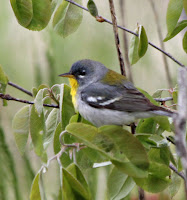 |
| Black & White Warbler |
I went birding yesterday morning at Salisbury Beach State Reservation, a place where I go instead of Parker River WMA when I have the dog with me (which is most of the time.) Driving slowly along the campground perimeter, I saw a warbler fly in front of the truck and pulled over. I could see some Black & White warblers through the truck window so I parked and immediately walked into a gaggle of flitting birds. (It was a good day in the area — at Parker River folks saw 22 species of warblers.)
 |
| Northern Parula |
 |
| Black-throated Blue Warbler |
The good news was that the trees are rather low and the birds close by. The bad news is that for a second-year birder, just getting them in the binoculars is a task, and then getting identifying marks etc is a challenge. Binoculars or camera, write notes or check Sibley’s, — oh for a knowledgeable birder along. It’s a good problem to have — too many birds, not enough expertise — that’s how you learn. I took my time, jotted down notes, shot a lot of photos, and came up with three new life birds.
 |
| Ovenbird |
Ovenbirds where everywhere — and unlike at home, easy to spot. I think that was because there were so many of them. Black-throated blue warblers likewise were putting on an aerial display going after insects like flycatchers.
I’m sure I missed a number of birds but it was demanding but fun — even when a couple of kids on their bikes set up a BMX route on the trail I was using.
 |
| Black-crowned Night-heron |
Leaving the reservation, I spotted a heron-like bird in the marsh and pulled over, let a runner pass, and backed up to the spot. I shot a couple of photos and tried to figure out what I was seeing — it wasn’t a Great Blue so I tried to make it into a Least Bittern. It wasn’t until I had a chance to look at the photos closely that I’ve decided it was a Black-crowned Night-heron. What it was doing up and about in the morning I have no idea?
Migration is so fleeting — a few weeks of birds passing through — and if you miss them, or can’t identify them, it’s wait until next year. But the flurry of frenetic activity, the chirps and calls, and the colors makes it a special time for birders.
